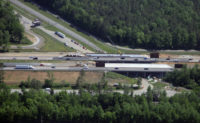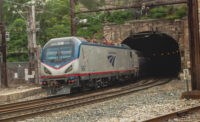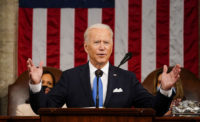READ: The latest updates on the Baltimore bridge collapse
The Francis Scott Key Bridge in Baltimore, which carries Interstate-695 Baltimore Beltway traffic, collapsed in the early morning hours of March 26, after a large container vessel collided with one of its through-truss central pylons. Eight members of a construction crew performing concrete deck pothole repairs on the four-lane bridge for the Maryland Transportation Authority were on the section that collapsed after being struck at 1:40 AM, and fell into the Patapsco River, Maryland Secretary of Transportation Paul Wiedefeld told reporters at a morning press conference.
Two were rescued but six remain unaccounted for, he said. None of the crew members were identified who were working on the bridge that Is operated by the authority. Wiedefeld said there is no indication of terrorism or any deliberate act.
According to the Baltimore Fire Dept., one of those rescued is in serious condition at an area hospital. The other person refused treatment. Sonar also detected the presence of several vehicles that fell in the 50-ft-deep Patapsco River, the department said.
The workers’ employer also was not identified initially, but at a later briefing by the National Transportation Safety Board (NTSB), which is investigating the accident, Chair Jennifer Homendy said they worked for contractor Brawner Builders Inc., Hunt Valley Md., but she cautioned that it is unclear whether some were employees of a company subcontractor, or multiple ones.
Maryland Gov. Wes Moore (D) said the vessel's crew told authorities that they lost power around the time of the collision. The bridge was also up to code, he said, with no known structural issues.
After a mayday call was made ahead of the collapse, workers stopped cars from continuing onto the bridge, a rapid response that Moore said saved lives. “These people are heroes,” he said.
Wiedefeld told CNN earlier that the ship looked like it was off course before the impact and that “obviously it should be in the main channel, which is under that main span.”
The National Transportation Safety Board (NTSB) is investigating the incident, among multiple federal and state agencies,
The incident occurred at 1:28 a.m. as the nearly 1,000-ft-long Singapore-flagged container vessel “Dali” was leaving the Port of Baltimore en route to Sri Lanka.
Video of the incident suggests that the vessel was in the process of turning when it struck the pylons supporting the main span, sending large parts of the steel super structure crashing onto the vessel and into the water.
Synergy Marine Group, the vessel owner, said in a statement that all crew members, including two pilots who were aboard, have been accounted for and there are no reports of any injuries among the crew.
The Key bridge opened in 1977 after a five-year, $110-million construction effort, with design by Singstad, Kehart, November & Hurka. Superstructure contractor Pittsburgh Des Moines Steel Corp. fabricated the main truss and John F. Beasley Construction Co. was the project steel erector.
Click here for details of the ENR project cover story.
The 8,636-ft long continuous through-truss bridge was the longest bridge in the metropolitan area and included the third-longest main span of its type in the world, says an ENR analysis (click on third photo of link for more detail).
According to Maryland state data, it carried more than 12.4 million commercial and passenger vehicles in 2023.
The collapsed bridge also blocks vessel access to the Port of Baltimore, the nation’s 15th largest port in container tons handled, according to the U.S. Bureau of Transportation Statistics. Its public terminals handled 11.7 million tons of general cargo last year, according to Maryland Ports Authority data, and 52.3 million tons of international cargo.
Federal Response
Speaking at midday March 26 from the White House, President Joe Biden addressed the Key Bridge collapse, pledging full federal support, in the aftermath of today’s Francis Scott Key bridge bridge collapse in Baltimore. That includes full federal funding for a replacement bridge. “It’s my intention that the federal government will pay for the entire cost of reconstructing that bridge," he said. "And I expect the Congress to support my effort.”
Biden said of the rebuild, “It’s going to take some time and the people of Baltimore can count on us to stick with them at every step of the way.”
He also said that ship traffic in the port has been “suspended until further notice,” adding, “And we’ll need to clear that channel before the ship traffic can resume.”
Biden said that the U.S. Army Corps of Engineers is “on the spot and will help lead this effort to clear the channel.”
He noted the importance of the port and said, “We’re going to get it up and running as soon as possible.”
Biden said he was directing his team “to move heaven and earth" to get the port reopened and a new bridge constructed.
NTSB Chair Jennifer Homendy, in an afternoon briefing near the site, said that “a search and rescue is still underway. So we are very hopeful.” But she noted, “It’s very early. We got here at 6 a.m. and we are standing back to allow the Coast Guard and search and [other agencies] “to continue their search and rescue operations.”
Homendy said the NTSB is gathering information from the command post near the site. “There is a lot of information that we can begin to collect.”
She said the safety board has a team of 24 on the scene, including an engineering team and a highway safety team that includes structural engineers and bridge specialists. Some are at the scene and others are on their there.
“There are a lot of entities right now in the command post, all focused on search and rescue–as they should be.”
Among the many entities there are people from the Army Corps of Engineers, which has “a great deal of expertise,” Homendy said.
She declined to provide a timeline for the accident.
Homendy added, ‘We are aware of what a structure should have. Part of our investigation will be how was this bridge constructed. It wlll look at the structure itself [and] should there be any sort of safety improvements.”
But she cautioned that investigations take time. She noted that with the recently completed NTSB investigation of the collapsed Fern Hollow Bridge in Pittsburgh, it took almost two years to get information on bridge inspections, what was done after those inspections and whether there were records maintained.







Post a comment to this article
Report Abusive Comment